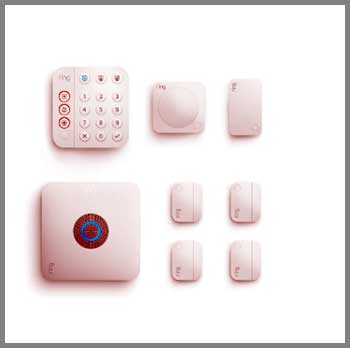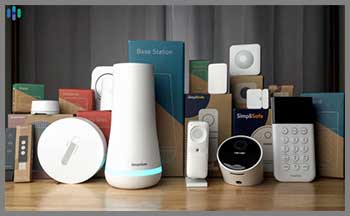I’ve always been a bit paranoid about home security. Maybe it’s from watching too many crime shows, but the thought of leaving my house unprotected makes me uneasy.
So, when I decided to upgrade my setup, I narrowed it down to two big players: Ring Alarm Pro and SimpliSafe. Both promise peace of mind, but which one delivers? In this article, I’ll break down their features, weigh the pros and cons, and share my experience testing them to help you decide which system fits your home.
Comparison Table: Ring Alarm Pro Vs. Simplisafe
| Feature | Ring Alarm Pro | SimpliSafe |
| Base Price | $249.99 (8-piece kit) | $249.96 (Foundation kit) |
| Monthly Monitoring Cost | $20 (Pro Plan) | $21.99–$79.99 |
| Professional Installation | $170–$249 | $125 |
| Smart Home Integration | Alexa, Google Home, Z-Wave | Alexa, Google Home |
| Camera Options | Indoor, outdoor, doorbell | Indoor, outdoor, doorbell |
| Video Storage | 180 days (with plan) | 30 days (with plan) |
| Battery Backup | 24 hours | 24 hours |
| Cellular Backup | Yes (with plan) | Yes (with plan) |
| Warranty | 2 years (extendable with plan) | Lifetime (with Fast Protect plan) |
| Privacy Rating | Moderate | High |
My Journey Into Home Security
When I moved into my current house—a cozy two-bedroom with a big backyard—I knew I needed a security system. I wanted something easy to set up, reliable, and not a budget-buster. After researching, Ring Alarm Pro and SimpliSafe kept popping up. Both are DIY-friendly, contract-free, and packed with features. But as I dug deeper, I realized they cater to slightly different needs. Let me take you through my experience with each, starting with what makes them tick.
Ring Alarm Pro: The Smart Home Champion
Ring Alarm Pro is like the cool kid who knows everyone. Owned by Amazon, it’s built to play nice with smart home gadgets. The base station doubles as an Eero Wi-Fi 6 router, which is a game-changer if your Wi-Fi signal struggles to reach your garage or backyard. I tested the 8-piece kit, which includes a base station, keypad, four contact sensors, a motion detector, and a range extender.
Key Features Of Ring Alarm Pro

The setup was a breeze. I plugged in the base station, followed the Ring app’s step-by-step guide, and had everything running in about 30 minutes. The app is slick—live video feeds, motion alerts, and system controls are all in one place. I paired it with a Ring Video Doorbell, and the night vision was crisp, picking up details like my neighbor’s cat sneaking across my porch at 2 a.m.
Ring’s smart home integration is where it shines. It works with Alexa, Google Home, and Z-Wave devices like smart locks and lights. I set up a routine where my porch light turns on when the doorbell detects motion—super handy. The Pro Plan ($20/month) includes professional monitoring, cellular backup, and 180 days of video storage for unlimited cameras. That’s a solid deal if you’ve got multiple Ring cams.
Pros of Ring Alarm Pro
- Seamless smart home integration. If you’re building a connected home, Ring’s compatibility with Alexa and Z-Wave is unbeatable.
- Built-in Eero Wi-Fi 6 router boosts your network, especially in larger homes.
- Affordable monitoring at $20/month, covering unlimited cameras.
- Wide range of cameras, including outdoor and doorbell options with excellent night vision.
- Flexible kits and add-ons let you customize without breaking the bank.
Cons of Ring Alarm Pro
- Privacy concerns. Ring’s history of sharing footage with law enforcement (without always needing a warrant) made me pause. If privacy’s a priority, this might bug you.
- Professional installation is pricey, starting at $170 for a small system.
- Some features, like arming/disarming via the app, require a subscription.
- Customer service can be hit-or-miss. I had to wait 20 minutes on hold when I called about a sensor issue.
- Setup can be trickier than SimpliSafe if you’re adding multiple components at once.
Also read: My Thoughts on Blink Vs. Yi Camera.
Simplisafe: The Straightforward Security Star
SimpliSafe feels like the dependable friend who always has your back. It’s been around since 2006, focusing on easy-to-use, renter-friendly systems. I tried the Foundation kit, which comes with a base station, keypad, one entry sensor, and one motion sensor. It’s minimal but scalable—you can add sensors, cameras, or even a smart lock.
Key Features Of Simplisafe
Installing SimpliSafe was so simple I almost felt like I was cheating. The sensors use peel-and-stick adhesive, and the app guided me through setup in under 20 minutes. The keypad is sleek and compact, unlike Ring’s bulkier version. I added an outdoor camera, which delivered solid 1080p video, though the night vision wasn’t as sharp as Ring’s.
SimpliSafe’s monitoring plans range from $21.99 (Standard) to $79.99 (Fast Protect). The Fast Protect plan includes Live Guard, where agents can view your camera feed during an alarm and intervene. That’s next-level protection. It also offers video verification, reducing false alarms by letting agents confirm intrusions before calling the cops. The system supports Alexa and Google Home but lacks Z-Wave, so smart home integration is limited.
Pros of SimpliSafe
- Dead-simple installation. Perfect for renters or anyone who hates DIY projects.
- High privacy rating. SimpliSafe uses 256-bit encryption and doesn’t share data with law enforcement unless legally required.
- Flexible monitoring plans, from self-monitoring ($9.99) to premium Live Guard ($79.99).
- Compact, discreet sensors blend into your home better than Ring’s bulkier ones.
- Lifetime warranty with the Fast Protect plan is a huge plus for long-term users.
Cons of SimpliSafe
- Limited smart home integration. No Z-Wave or Zigbee support means fewer connected devices.
- Cameras are average. The indoor and doorbell cams don’t match Ring’s quality or variety.
- Higher monitoring costs, especially for premium plans ($31.99–$79.99).
- Video storage is capped at 30 days, compared to Ring’s 180 days.
- Professional installation, while cheaper than Ring at $125, still feels unnecessary given how easy DIY is.
Breaking Down The Differences
Now that I’ve lived with both systems, let’s compare them across key areas to see where they excel or fall short.
- Installation and Setup
SimpliSafe wins hands-down for ease of use. I had it up and running faster than it took me to make dinner. The peel-and-stick sensors are foolproof, and the app’s instructions are clear. Ring’s setup isn’t hard, but pairing multiple devices (like cameras and sensors) took longer, and I had to fiddle with the range extender to cover my backyard. If you’re not tech-savvy, SimpliSafe is the way to go
- Equipment and Customization
Both offer scalable systems, but Ring has more variety. Its kits range from 5 to 14 pieces, and you can add outdoor cameras, smart lighting, or solar panels. SimpliSafe’s packages (Foundation to Haven) are tailored to home size, with extras like glass break sensors and panic buttons. However, Ring’s cameras are superior—more options and better video quality. SimpliSafe’s sensors are smaller and less obtrusive, which I appreciated in my minimalist living room.
- Monitoring and Subscriptions
Ring’s $20 Pro Plan is a steal, covering professional monitoring, cellular backup, and video storage for unlimited cameras. SimpliSafe’s plans are pricier, starting at $21.99 for basic monitoring and jumping to $79.99 for Live Guard. But SimpliSafe’s video verification and Live Guard features add serious value, especially in high-crime areas. If you want basic monitoring, Ring’s cheaper. For advanced protection, SimpliSafe’s worth the extra cost.
- Smart Home Integration

Ring dominates here. Its Z-Wave support and deep Alexa integration let me control lights, locks, and cameras with voice commands. SimpliSafe works with Alexa and Google Home, but it’s clunky—you can’t control as many devices, and there’s no Z-Wave or Zigbee. If you’re all-in on a smart home, Ring’s your pick.
- Privacy and Security
SimpliSafe takes the lead. Its 256-bit encryption and strict data-sharing policies gave me confidence. Ring’s privacy track record is shakier—Amazon’s been criticized for sharing Ring footage with police without user consent. Both systems use cellular backup and 24-hour battery power, so they’re reliable during outages. But if privacy’s non-negotiable, SimpliSafe’s the safer bet.
Read More: My Thoughts on Blink Vs. Kasa Indoor Security Camera.
- Customer Service
SimpliSafe edges out Ring. I reached a SimpliSafe agent via live chat in under a minute when I had a question about my camera. Ring’s support took longer, and I got bounced between reps. SimpliSafe’s 60-day return window and lifetime warranty (with Fast Protect) beat Ring’s 30-day returns and 2-year warranty.
Real-World Testing: My Experience
I tested both systems for a month each, and they handled real-life scenarios differently. One night, my dog knocked over a plant, triggering a motion sensor. SimpliSafe’s app alerted me instantly, and I disarmed it from my phone. Ring’s alert came a few seconds later, but the live feed loaded faster, letting me see my guilty pup right away.
During a power outage, both systems switched to battery and cellular backup seamlessly. But Ring’s Wi-Fi router kept my smart devices online, which was a bonus. SimpliSafe’s cameras struggled with motion detection at night, missing a raccoon rummaging through my trash. Ring’s doorbell cam caught it in HD.
For a renter like my friend Sarah, SimpliSafe’s portability and no-drill setup were perfect. But for my smart-home-obsessed brother, Ring’s integrations and Wi-Fi boost made it a no-brainer. Your needs will tip the scales.
Which System Should You Choose?
Picking between Ring Alarm Pro and SimpliSafe depends on your priorities. If you want a budget-friendly system with top-notch smart home integration and a Wi-Fi boost, Ring’s your best bet. It’s ideal for homeowners with multiple cameras or a growing smart home. But if privacy, simplicity, and advanced monitoring matter most, SimpliSafe delivers. It’s great for renters, small homes, or anyone who wants a no-fuss setup.
I leaned toward SimpliSafe for its privacy and ease of use, but Ring’s smart features tempted me. Ultimately, I stuck with SimpliSafe because I value peace of mind over flashy integrations. You’ll need to weigh what matters most to you—smart home control or straightforward security.
Frequently Asked Questions (Faq)
It depends. Ring Alarm Pro is better for smart home enthusiasts and those needing affordable monitoring with lots of cameras. SimpliSafe excels in privacy, ease of installation, and advanced monitoring features like Live Guard.
Other systems like ADT or Vivint offer more features but require contracts and higher costs. For DIY, Ring Alarm Pro is a strong alternative if you prioritize smart home integration.
Ring Alarm Pro’s downsides include privacy concerns, pricier professional installation, and inconsistent customer service. Some features also require a subscription.
The Ring Alarm Pro monthly fee is $20 for the Pro Plan, which includes professional monitoring, cellular backup, and 180 days of video storage.
Conclusion: Your Home, Your Choice
After testing Ring Alarm Pro and SimpliSafe, I’m convinced both can keep your home safe—it’s about what fits your lifestyle. Ring’s smart home prowess and Wi-Fi boost are hard to beat if you love tech. SimpliSafe’s simplicity and privacy focus make it a rock-solid choice for straightforward security. Think about your needs: Are you a renter? A smart home geek? Budget-conscious? Whatever you choose, you’ll sleep better knowing your home’s protected. Now, it’s your turn to decide—Ring or SimpliSafe?
